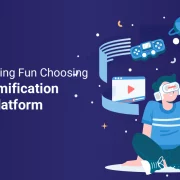
6 Ways to Use Interactive Technology in Your Curriculum Development Model
The integration of technologies in the learning process has positively impacted the whole education system. Leveraging interactive technologies such as a learning app, AR, VR, simulations, etc., is a great way to grab students’ attention and involve them in the learning process. They are highly efficient in keeping students engaged during their online learning journey. And this is why educational institutions are now looking to embed interactive technologies in their curriculum development model.
Incorporating interactive technologies will boost engagement and help students improve their understanding of concepts, learn new skills, and enhance their overall learning experience.
Table of Contents:
- Benefits of Interactive Technology in Education
- How to Introduce Interactive Technology as a Part of the Curriculum Development Model?
- Conclusion
Benefits of Interactive Technology in Education
Here are the key benefits of integrating interactive technologies with curriculum development models.
1. Interactive engagement
Interaction is a crucial aspect of online learning. Several eLearning tools like videos, games, 3-D quizzes, simulations, etc., help keep learners attentive and engaged. Interactive learning methods improve not only a student’s engagement but also their participation in the classroom. Integration of virtual reality in learning methods allows better learners’ involvement and prepares them to deal with real-life situations.
2. Improves practical skills
Contrary to traditional bookish knowledge-gathering, interactive learning improves the communication and problem-solving skills of learners. Integration of technology also allows educators to use different online tools and applications to make the topics more understandable. Educators can explain complex technicalities or concepts easily by using visual tools or simulation programs.
3. Diverse and distinct
Integrating technology in learning allows educators to use interactive learning tools and gadgets in their teaching plans. Educators can incorporate a variety of learning styles to make their lessons attractive to students.
4. Environment-friendly
Implementation of online and interactive learning methods can reduce the usage of printed study materials like books, printouts, and writing papers, ultimately minimizing paper consumption and saving the planet.
5. Time-saving
The whole eLearning system is highly time-saving to both educators and students. Students today have access to different tools and educational apps that enhance their learning experiences. They study independently, take up assignments, and appear for tests online, which is faster than traditional systems. On the other hand, instructors can share customized study material through a common path; even the evaluation process can be simplified with a predefined scoring scheme. All these procedures have accelerated the learning process significantly.
6. Employment-ready
Interactive learning methods promote creativity and critical thinking ability and improve the learners’ problem-solving skills. This makes students ready to deal with real-world problems and improves their decision-making ability. Apart from these, students get exposure to different technologies and skills that allow them to adapt to different professional fields more efficiently and smoothly.
How to Introduce Interactive Technology as a Part of the Curriculum Development Model?
There are multiple ways to embed interactive technology in curriculum development models to improve the learning process:
1. Simulations
Simulation technology mimics real-life scenarios to practice problem-solving skills that students might require in similar real-life situations. Here, learners have to recall their theoretical knowledge and apply it in a simulated environment. This process of learning is highly effective for knowledge retention. Simulation technology creates a positive but restricted environment to encourage experimentation and let students learn from their mistakes. Learners can master their skills by solving problems in a safe environment and making mistakes without repercussions.
2. Active learning forum
It essentially refers to an online learning forum where educators and learners collaborate and participate in active learning sessions, just like in regular classrooms. Active learning is fuelled by multiple tools and technologies that facilitate interactive discussions, enable online quizzes, real-time debates, collaborative document creation, etc.
3. Gamification
Integration of gamification in curriculum development models allows educators to incorporate interactive games into their lesson plans. There are multiple ways to integrate games into the classroom to enhance the learning process, such as setting regular class competitions, providing badges or rewards to students for their achievements, creating different levels of learning that students can achieve, etc.
4. Virtual reality and augmented reality-based learning
VR technologies allow learners to interact with the learning materials to achieve a higher level of understanding. VR-based learning programs motivate students to learn more and enable them to implement their learning in real-life scenarios. Similarly, AR facilitates educators and learners to perform tasks in a secure environment, which helps training purposes.
Implementing VR and AR in curriculum development models can widen learning opportunities by providing differentiated and customized learning experiences for students. These are effective ways to make learning exciting and fun.
5. Collaborative distance learning system
There are multiple tools to collaborate for distance learning virtually. Apart from creating personal learning networks for online collaboration, institutes can leverage the numerous online collaborative tools already available, such as Padlet, TodaysMeet, Socrative, Twilda, Collaborate Classroom, Scribblar, etc.
6. Instructional tools
A wide variety of instructional tools are available to support the online learning infrastructure. Incorporation of tools like an online whiteboard (e.g., Lucidspark, Microsoft Whiteboard), effective response systems (e.g., clicker technology), online collaboration tools (e.g., Google Drive, Edmodo, Yammer, Skype), and so on can improve the interactive learning process.
Conclusion
Interactive learning technologies have emerged as an efficient method to boost learners’ engagement, leading to better learning outcomes. Educational institutions must embed interactive tools and technologies in their curriculum development models to keep the tech-savvy learners engaged in the learning process. Especially now, when students are getting habituated to online learning methods, it has become essential to make the curriculum engaging by using the latest learning technologies.
Since learners’ requirements have changed, it’s time to incorporate interactive learning technologies in the curriculum, not only for a better understanding of the subject matter but also for developing critical thinking power in learners to deal with real-world scenarios.
Need to know more about our Products & Services? Drop us a note at marketing@hurix.com.

Senior Vice President – Business Development
Over 25 years of experience in the edtech and workforce learning industry with strong skills in Business Development, Customer Relationship Management (CRM) and Strategy.



